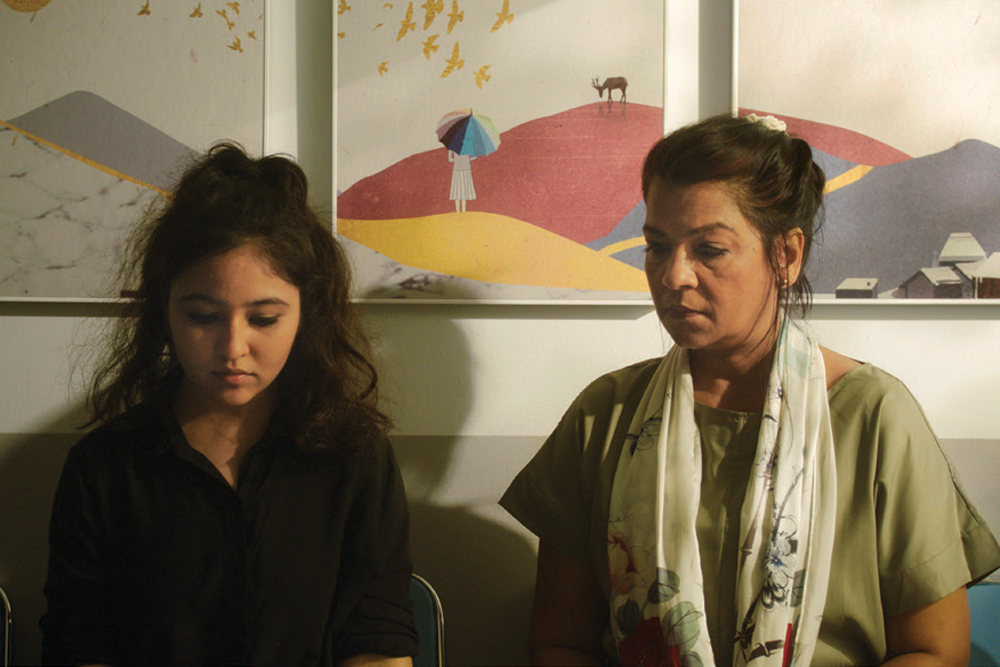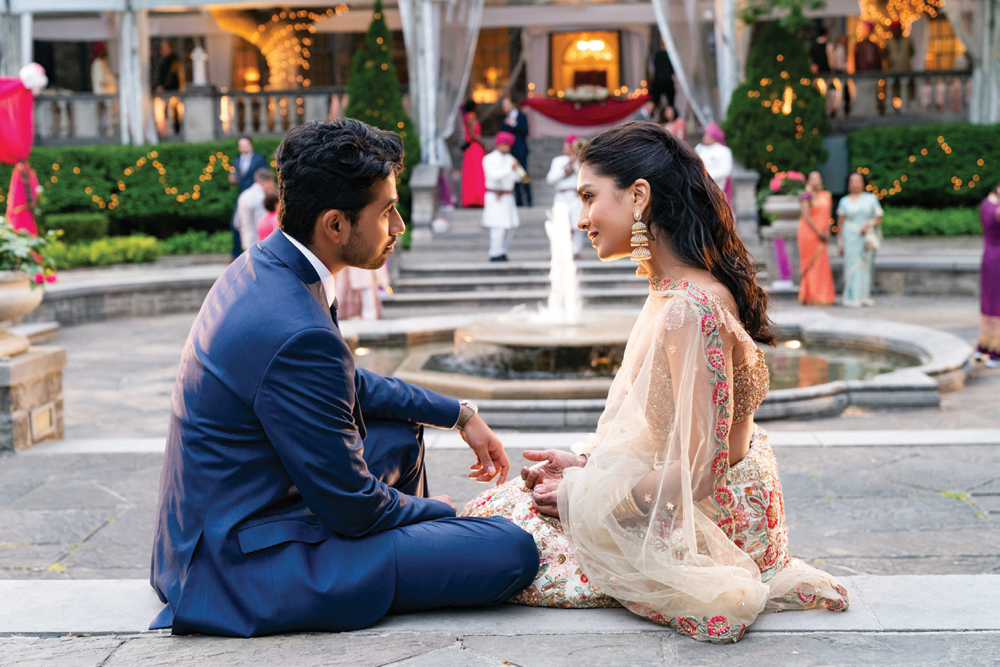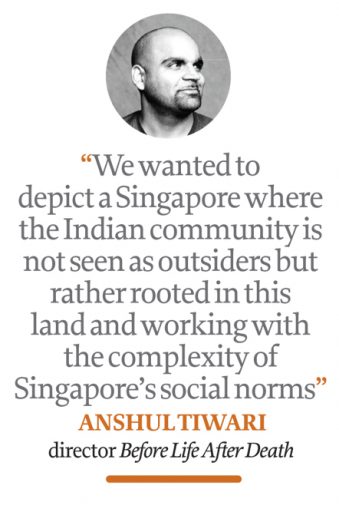Pride and Pomp
The diaspora experience is not trapped in nostalgia any longer
 Manik Sharma
Manik Sharma
 Manik Sharma
Manik Sharma
 |
09 Jun, 2023
|
09 Jun, 2023
/wp-content/uploads/2023/06/PrideandPomp.jpg)
A scene from Polite Society
IN A SCENE from Anshul Tiwari’s Before Life After Death, Radhika, an Indian-origin gynaecologist based in Singapore tells Gauri, a young girl contemplating an abortion “Ye koi purani Hindi film nahi hai (This is not some old Hindi film)”. Radhika intends to impress upon Gauri the importance of de-romanticising the cultural codes modern Hindi cinema had in the 1990s inculcated as a sort of franchise. Reality, in comparison, is far more complex. It is disinterested, for the most part, in accommodating woes born from idylls of morality, nostalgia, love for the homeland etc. Radhika’s jibe is partly a rebuttal of the sweeping image Hindi cinema manufactured for diaspora Indians through the ’90s.
Tiwari’s sincere, if at times timid, portrayal of immigrants released on the same day this year as Nida Manzoor’s Polite Society. Cut from different cloth, Manzoor’s pulpy, comic-book action fiesta tackles the one subject that diaspora Indians have obsessed over for decades—marriage. Replete with clever action set-pieces, stinging one-liners, Manzoor’s film exaggerates the whispery, sensational aura of two decades ago when diaspora cinema boomed, especially through the accounts of its many women moving past social and cultural borders. Twenty years later, stories set in the diaspora are becoming commonplace again. This time, however, they feel embedded, self-confident about the worlds they inhabit, as opposed to older films that jostled with both landscapes and cultural idioms.
The first comprehensive image of the Indian diaspora materialised in the mainstream with Shah Rukh Khan’s emergence as a ‘yuppie’ modern hero. A domesticated portrayal of the chaste Indian yearning for a home, these narratives led to Bollywood’s expansion into markets beyond the country’s borders. This was, of course, a post-globalisation era of economic expansion and tech innovation. Khan and his version of the diaspora, however, was bullish, sweeping and at times ignorant of ground realities that many Indians actually dealt with. It was a job women from within the diaspora decided to shoulder.
In 1991, Mira Nair directed Mississippi Masala, a story of immigrants mixing it up in a conservative corner of America. Nair’s film grammar—a more sombre, unflattering portrayal of immigrant life—was almost antithetical to traditional Bollywood. Across the Atlantic, Gurinder Chadha’s Bhaji on the Beach (1993) used a different treatment to explore immigrant life in the UK. Fronted by a terrific Zohra Sehgal, Bhaji on the Beach is a delightfully chaotic analysis of generational tension between immigrant women.
Both Nair and Chadha, though different in their approach and syntax, would make iconic films at the turn of the century. Chadha’s Bend It Like Beckham (2002) was a hit, lauded for its attempt to demilitarise the guarded Indian household and for a change, show the conservative Indian as a wildly exportable identity. Mira Nair’s Monsoon Wedding (2001), on the other hand, was a rousing drama, and spawned the obsession with Indian weddings.
Alongside Nair and Chadha, Indo-Canadian director Deepa Mehta also produced Sam & Me (1991), starring the late Om Puri, about a man who travels to Toronto to escape his life in India. With Bollywood/Hollywood (2002) she produced a somewhat unconvincing satire of Bollywood’s tacky, sing-song grammar that, though endearing to most Indians, continued to alienate younger NRIs who believed Bollywood to be the “opposite of cool”.
By the end of the ’90s, the Indian diaspora wasn’t just a market that Mumbai-set studios were hoping to target. It became a flourishing landscape for stories to bloom out of. Damien O’Donnell’s East Is East (1999), though not about an Indian family, sees Om Puri play the stubborn patriarch of a Pakistani family in 1970s England struggling to contain the transgressions of an anglicised son. It’s a story that despite its obvious origin translates seamlessly across the border, a fact of sub-continental heritage that has never been explored enough. In 2001, Piyush Dinker Pandya made the rather popular American Desi, a coming-of-age film that circles the lives of three Indian roommates, largely unattached to their native heritage.

Of late, diaspora portrayals have come to suggest an ease with the landscapes they are set in. Indians have begun to tell stories where they feel like citizens of the world. They still tackle conflict, but it isn’t necessarily about the homeland left behind. “We wanted to create a narrative around the disparity among Singaporeans of Indian origin. From there emerged the idea of sisterhood and how women can empower each other despite social, and economic disparity. People often talk about the fault lines where Singapore’s diversity has clear-cut boundaries despite sharing the same space. But we wanted to depict a Singapore where the Indian community is not seen as outsiders but rather rooted in this land and working with the complexity of Singapore’s social norms,” Tiwari says about Before Life After Death.
The diaspora footprint is also extending to different lands and sub-cultures. While Tiwari’s Singapore-based film has the backdrop of Tamilian descendance, in Agam Darshi’s Canada-based Donkeyhead (2022), the story takes place within a Sikh immigrant family. A play on the Punjabi word “khota”, the film shows four siblings converging at their childhood home to oversee their ailing father. “It was surprisingly not challenging to get Donkeyhead made. But maybe if I made it 10 years ago, it would have been a very different situation. But the script was supported and our funders were really excited to see a film like this come alive. I think people see the need for diverse voices in today’s climate,” Darshi, the actor-director behind the film, says about the challenge of making films on South Asian stories for global audiences.

These films also arrived on the heels of pop culture trends veering towards a South Asian preoccupation. Priyanka Chopra has, after Citadel (Prime Video), become somewhat of a global star. With shows like Mindy Kaling’s Never Have I Ever (about to screen its last season), Disney’s Ms Marvel, and characters like Rajesh Koothrappali played so charmingly (of late controversially) by Kunal Nayyar in The Big Bang Theory, subcontinental brown identities have begun to emerge as globally recognised narratives. What has probably also helped is the assertiveness with which new characters are wedding themselves to the fabric of the modern world as opposed to suspecting it, like we did decades ago. In Darshi’s Donkeyhead, a character reluctantly but un-animatedly comes out of the closet. In Tiwari’s film, a teenager contends with an unplanned pregnancy (think of Juno). In both films, the moral spectre of ‘Indianism’ seems to have lifted to make way for concerns more universally translatable. The ‘Indianness’ just happens to be the canvas.
“On one hand, there are the ‘old Indians’ naturalised from Singapore’s inception in 1965 and even before. They played a key part in nation-building during its rapid growth, and carry pride in Singaporean values and its racial diversity. Tamil is one of the official languages in Singapore. Then there are ‘new Indians’, the expats who came in the late 1990s and early 2000s, they spoke Hindi and other languages, enjoyed Singapore’s comforts, and fuelled Singapore’s economic growth but do not associate with its local culture and politics even though they have Singapore nationalities,” Tiwari says of the many interesting ways Indians continue to interpret foreign cultures.

Tiwari’s film evokes the expanding footprint of the global Indian, now appearing in places other than the US and UK. This extended footprint is more diverse than the elite, moneyed avatars of popular Hindi cinema at the turn of the century. “We wanted to explore how the Indian population due to its cultural leanings deals with Singapore’s social support systems. There are many abortion-related stories from Singapore’s Chinese or Malay population but hardly any from the Indian population. We have come across many such cases that are not reported in the media or mainstream TV. We wanted to show people who are a common sight in our food courts, and hawker centres, yet absent from popular narratives,” Tiwari adds.
While some aspects of the diaspora’s portrayal have evolved, some continue to echo dated tropes. Marriage is still a pivotal moment in an Indian immigrant’s life, peppered with anxieties around class, caste and other Indian specificities. And then there are the aunties, middle-aged, casually spiteful women who stand for both conservatism and societal overreach. In the Netflix film Wedding Season (2022), an Indian pair bond over their mutual distaste for Indian marriages. They come up with a clever guise, to pretend to be into each other, just to get “matchmaking aunties” off of their backs. In Donkeyhead, two aunties gawk at the sight of a woman smoking a cigarette, the only sequence in the film that doffs its hat to a timeless trope. On Netflix, Sima Taparia’s exploits as an aunty going around marrying off the country’s elite bachelors have led to the audiences’ awkward obsession with Indian Matchmaking.
The first comprehensive image of the Indian diaspora materialised in the mainstream with Shah Rukh Khan’s emergence as a ‘yuppie’ modern hero. This version was at times ignorant of ground realities. It was a job women directors from within the diaspora decided to shoulder
The reappearing aunties, Darshi explains, are merely recreations of a reality that exists. “I think they are popular and relevant because firstly, they’re real. This is the truth in a lot of families. Indian culture, particularly Punjabi culture, is very patriarchal. But law and traditions are kept inside the homes by many of these strong women. Unfortunately, their strength is still tied so much to the patriarchy where they judge and condemn many who don’t adhere to these traditions. This is obviously a generalisation, but it also holds so much truth,” she says. That said, a more empathetic exploration of first-generation women parachuted into foreign lands without the agency of money, possessions or cultural roots to latch onto, deserves a portrayal or two of its own. It’s probably what makes the aunties pesky. They might know a thing or two about feeling unanchored. Darshi’s film, set in a modern Sikh immigrant family, also contradicts the larger-than-life portraits that Punjabi cinema constructs for audiences back home. It’s a flattering portrayal that the actor says she finds hard to buy. “I don’t see Donkeyhead as ‘sober’. I see it as honest and real. But without melodrama,” she says.
The portrait of the Indian diaspora has clearly undergone evolution, detaching itself from the concerns of a post-globalisation India. It’s a narrative that Tiwari claims needed changing. “Many diaspora stories carry the same traits—arranged marriages, pressures of the youth dealing with overprotective parents, an often funny, exaggerated display of Indianness, Hindi versus English, and Bollywood,” he says. Darshi’s next projects are a mix of both South Asian and non-South Asian narratives. “Actors are more than their ethnicity and their religion,” she says, underlining the global Indian’s ability, of late, to become much more than their anxiety about their roots. They have now comfortably branched out into citizens of the world.

/wp-content/uploads/2025/07/Cover_Dalai-Lama.jpg)












More Columns
From Entertainment to Baiting Scammers, The Journey of Two YouTubers Madhavankutty Pillai
Siddaramaiah Suggests Vaccine Link in Hassan Deaths, Scientists Push Back Open
‘We build from scratch according to our clients’ requirements and that is the true sense of Make-in-India which we are trying to follow’ Moinak Mitra